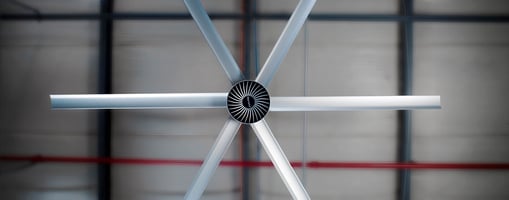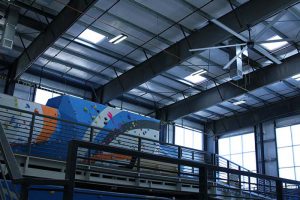High-volume, low-speed (HVLS) fans are extremely popular; they can be found in warehouses, gyms,...
Understanding the Lifetime Operating Costs of an HVLS Fan
Many facility managers and engineers who are choosing new fans for their buildings make the mistake of only considering the upfront costs of the fan. While it's true that upfront costs represent a significant portion of the price of a fan, the purchase price isn't the only factor that determines the lifetime operating costs of a fan. Let's take a look at some of the most common elements that determine HVLS fan lifetime operating cost.

Warranty
The warranty on your HVLS fan has a huge impact on how much the fan costs over its lifetime since it determines how much coverage is provided by the manufacturer for repairs, replacement, and maintenance.
The warranty's impact on a fan's lifetime cost is fairly simple: the longer and more thorough the warranty is, the lower the cost of the fan over its lifetime.
Quality Construction
What's your fan made out of? It's easy for a manufacturer to use inferior parts, shave $500 - $1000 off the price of the fan, and claim that their fans offer a better value than their competitors’ fans. But don't this tactic fool you. Companies that use lesser-quality materials often provide limited warranties. By doing so, they save money and shift the burden of repairing and maintaining fans to customers. High-quality HVLS fans may cost more upfront, but over the long run, they will save you more money than a less expensive fan built with worse parts.
Energy Usage
Energy consumption is another big indicator of the overall lifetime costs of a fan. The more energy a fan uses, the higher your utility bills will be each month. Don’t be too concerned with how much airflow an HVLS fan has at maximum power, instead look at how much energy is consumed operating the HVLS fan at optimal speed, which is typically 60%. Having to run your HVLS fan at maximum speed day in and day out will only increase the wear and tear on the fan and shorten its lifespan.
Electricity costs might not seem like a significant price difference, but they are. Just consider a fan that costs just $50 more per month operating to achieve optimal airflow. At $600 extra each year, assuming that an HVLS fan operates for at least 10 years, you are looking at a minimum of $6,000 extra in energy costs. Even if the other fan you were considering costs $1,000 more upfront, it's well worth the extra price. You'll reap the rewards from using less energy, and that equals long-term savings.
The Bottom Line
Any time you are looking to purchase an HVLS fan, it is critical to understand the HVLS fan lifetime operating cost. Consider all costs, not just the upfront ones. Keep the above factors in mind, and you'll be able to save money on your next HVLS fan purchase.


